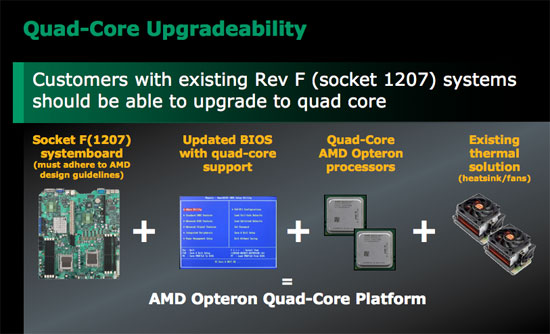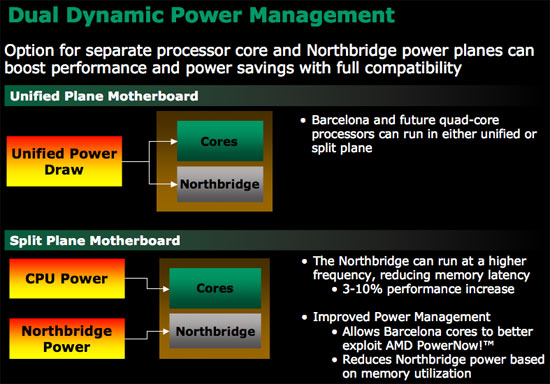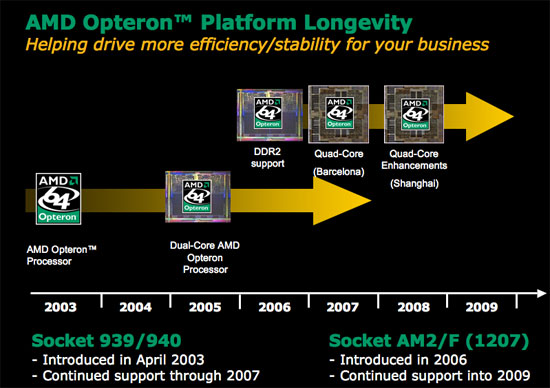New Details on Barcelona Emerge
If you've been following AMD's latest roadmaps then you'll know there are a couple of new sockets on the way. While AMD's next-generation CPUs will work in current Socket-AM2 and Socket-1207 motherboards, a new class of boards will launch with support for Socket-AM2+ and Socket-1207+. Inevitably the question you will ask yourself is: what does the + get you?
The pinout of Socket-AM2 and Socket-AM2+ is identical, and likewise Socket-1207 and 1207+, and thus the same Agena or Barcelona will work in both sockets, which is how AMD is able to guarantee full backwards compatibility with current AM2 and 1207 motherboards. If you do buy a new motherboard that uses either Socket-AM2+ or 1207+, you will get some additional functionality.

Current platforms only support HyperTransport 2.0, while the new + platforms will enable HT3.0 which brings faster link speeds and greater bandwidth. For desktops, a faster HT link won't really change performance, but in multi-socket workstations and servers there will be a benefit.

The more tangible feature is the ability to support split voltage planes. As we mentioned in our preview of AMD's Barcelona architecture, the CPU cores and the Northbridge can operate at different voltages and frequencies. In order to enable this functionality, you need motherboard support, thus if you want the power benefits of having the Northbridge and CPU cores on independent power planes you need an AM2+ or 1207+ motherboard.
It's not all about saving power with split voltage planes, as there's also a performance benefit to going AM2+/1207+. When the Northbridge is placed on its own power plane, the motherboard can actually apply more voltage to it than the CPU cores and run it at a slightly higher frequency on the order of a 200 - 400MHz increase. The Northbridge is an extremely low power part of the CPU die and an increase in voltage/clock frequency results in a minor increase in TDP, but it can drive a disproportionately large increase in performance.
With AM2+/1207+ systems, the Northbridge runs at a higher frequency and thus the memory controller sees slightly lower latencies. The shared L3 cache also operates on the same power plane as the Northbridge, reducing L3 cache latency as well. AMD expects the overall performance advantage by going with AM2+/1207+ to be on the order of 3 - 10% over current motherboards.

While your current motherboards will work with AMD's forthcoming CPUs, you'll get better performance out of upcoming Socket-AM2+ and Socket-1207+ platforms. AMD does plan on supporting both AM2 and 1207 into 2009, so you can expect a continued upgrade path for your AMD platforms well after Agena/Barcelona.
If you've been following AMD's latest roadmaps then you'll know there are a couple of new sockets on the way. While AMD's next-generation CPUs will work in current Socket-AM2 and Socket-1207 motherboards, a new class of boards will launch with support for Socket-AM2+ and Socket-1207+. Inevitably the question you will ask yourself is: what does the + get you?
The pinout of Socket-AM2 and Socket-AM2+ is identical, and likewise Socket-1207 and 1207+, and thus the same Agena or Barcelona will work in both sockets, which is how AMD is able to guarantee full backwards compatibility with current AM2 and 1207 motherboards. If you do buy a new motherboard that uses either Socket-AM2+ or 1207+, you will get some additional functionality.

Current platforms only support HyperTransport 2.0, while the new + platforms will enable HT3.0 which brings faster link speeds and greater bandwidth. For desktops, a faster HT link won't really change performance, but in multi-socket workstations and servers there will be a benefit.

The more tangible feature is the ability to support split voltage planes. As we mentioned in our preview of AMD's Barcelona architecture, the CPU cores and the Northbridge can operate at different voltages and frequencies. In order to enable this functionality, you need motherboard support, thus if you want the power benefits of having the Northbridge and CPU cores on independent power planes you need an AM2+ or 1207+ motherboard.
It's not all about saving power with split voltage planes, as there's also a performance benefit to going AM2+/1207+. When the Northbridge is placed on its own power plane, the motherboard can actually apply more voltage to it than the CPU cores and run it at a slightly higher frequency on the order of a 200 - 400MHz increase. The Northbridge is an extremely low power part of the CPU die and an increase in voltage/clock frequency results in a minor increase in TDP, but it can drive a disproportionately large increase in performance.
With AM2+/1207+ systems, the Northbridge runs at a higher frequency and thus the memory controller sees slightly lower latencies. The shared L3 cache also operates on the same power plane as the Northbridge, reducing L3 cache latency as well. AMD expects the overall performance advantage by going with AM2+/1207+ to be on the order of 3 - 10% over current motherboards.

While your current motherboards will work with AMD's forthcoming CPUs, you'll get better performance out of upcoming Socket-AM2+ and Socket-1207+ platforms. AMD does plan on supporting both AM2 and 1207 into 2009, so you can expect a continued upgrade path for your AMD platforms well after Agena/Barcelona.










55 Comments
View All Comments
osalcido - Sunday, May 13, 2007 - link
Like they price gouged when X2s were introduced?If so, I hope Intel kills them off. If I'm gonna get gouged I'd rather it be by a monopoly so maybe the government will do something about it
Spoelie - Sunday, May 13, 2007 - link
there was really no price gouging as far as I know. AMD was capacity constrained, they were selling every possible cpu they could make at those prices, and even had backorders. I remember that around the summer of 2005, they had sold out their capacity for at least the next 6 months.It would be absolutely economically INSANE to lower prices under those conditions. If you sell every single cpu you can make, you're not gonna lower prices to increase demand..
But well yeah, around feb 2006 came the news of core 2 ;)
Kougar - Sunday, May 13, 2007 - link
I'm not sure, but whatever image protection you are using to protect direct image linking seems to now be breaking ALL images in Opera. I have had problems in the past regarding Anandtech review/article images, but chalked it up to a browser setting I could not pin down.So far it still only happens with Anandtech images, and after a full reinstall of Opera 9.20 I still can't see any images or any image placeholders in this article. I did not know there was even any images until I got to page 7 where the captions were left hanging in midpage. I really hate having to switch to IE7 to read articles, so if this can be easily fixed I'd very much appreciate it. Thanks.
If it helps any, if I am looking for it I can sometimes spot an image start to load, before it is near instantly removed from the page and the text reshuffled to fill the empty void.
bigbrent88 - Sunday, May 13, 2007 - link
I know this may be a simple way to look at AMD's Fusion and future chips based on that idea, but isn't this close to what the Cell already is. Imagine you could remake the cell with a current C2D(using current power leader) and include more, better SPE's with something like HT in AM2 and all of this is on a smaller die than you could do now. Would that not be the basic first step they are going to take? Many have said the Cell is ahead of its time and I also agree that some design elements are inhibiting its overall power, but the success of Folding shows what the Cells processing can do in these types of environments and thats what AMD is looking at in the near term.I just can't wait to drop my x2 3800 and get a good upgrade to go along with that new DX10 card sometime in the next year. Bring it AMD!
noxipoo - Friday, May 11, 2007 - link
get everything in focus for christ sakes.plonk420 - Friday, May 11, 2007 - link
it's interesting how many commercial programs aren't multithreaded. take a look at this year's Breakpoint demos/intros, and just about ALL the top 3 or 5 (or more) take advantage of 2 cores (i don't have more than 2 to know if they would make use of the extra ones or not). check out the Breakpoint 2007 entries at pouet.net and fire something up with a Task Manager open on a second monitor and see for yourself ;)OcHungry - Friday, May 11, 2007 - link
From the tone of your article I have no doubt AMD is about to put Intel where it belongs, in the so so technology arena with lots of marketing maneuvering to sell inferior products. I like the Jetliner graph where the air bus is taking off at a steep angle and the other small jet is going horizontal w/a little inclination. That says it all, and how the 2 (Intel and AMD) are perceived in the technology world.It’s like this: Intel refines the same old, but AMD is into innovation and new things. Good for AMD, it’s about time. The heteroggenenous architecture, the fusion, and Torenza, are where computing technology should be heading, and AMD is taking the lead, as always. I live in Austin, TX, and have a few friends working @ AMD and tell me: buy AMD shares as much as you can, because good things are about to explode and neither Intel, nor Nvidia can catch up to it, ever.
sandpa - Friday, May 11, 2007 - link
actually they are asking everybody to buy AMD shares so that they can sell off their worthless AMD stock for a better price :) dont listen to them ... they are not your friends. No one will be able to catch up with AMD "ever" ??? yeah keep dreaming fanboi!OcHungry - Friday, May 11, 2007 - link
Yeah right. Tell that to Fidelity who bought more of AMD shares lately (13% total).And I guess the rise in price yesterday and today were meaningless?
Intel marketing thugs are at work, no change there.
http://www.theinquirer.net/default.aspx?article=39...">http://www.theinquirer.net/default.aspx?article=39...
yyrkoon - Friday, May 11, 2007 - link
This is exactly what I was thinking while reading, then I ran into the above paragraph, and my suspicions were 'reinforced'. However, if this is the case, I can not help but wonder what will happen to nVidia. Will nVidia end up like 3dfx ? I guess only time will tell. There is a potential problem I am seeing here however, if we do finally get integrated graphics on the CPU die, what next ? Audio ? After a while this could be a problem for the consumer base, and may ressemble something along the lines of how a lot of Linux users view Microsoft, wit htheir 'Monopoly'. In the end, 'we' lose flexability, and possibly the freedom to choose what software that will actually run on our hardware. This is not to say, I buy into this beleif 100%, but it is a distinct possibility.
Apparently Intel suspects something is going on as well. One look at the current prices of the E6600 C2D should confirm this, as its currently half the price of what it was a month ago. Unless, there is something else I am missing, but the Extreme CPUs still seem to be hovering around ~$1000 usd.
I am very pleased to hear that AMD is continuing support for Socket AM2. It was my previous belief, that they were going to phase this socket out, for a newer socket, and if this was the case a few months ago, I am glad that they listen, and learn. Releasing products that underperform the competition is one thing, but alienating your user base is another . . . That being said, I really do hope that Barcelona/K10/whatever the hell the official name is, will give Intel some very tight competition (at least).
I can completely understand why AMD is being tight lipped, I have suspected the reasons why for some time now, and personally, I believe it to be in their best interrest to remain doing so. And yes, it may reflect badly on AMD at this point in time, but what would you preffer ? Intel learning your secretes, and thus rendering them moot, or a few 'whinners', such as ourselves, not knowing what is going on ? They are doing the right thing by them, and that is all that matters. No one, including Intel 'fanboys' want AMD to go under, they may think so, until it really does happen, then they are locked into whatever Intel deems nessisary, which is bad for everyone.
Now, if AMD could come up with something similar to vPro/AMT, or perhaps AMD/Intel could make a remote administration (BIOS, or similr level) 'Standard', I think I would be happy, for at least a little while . . .